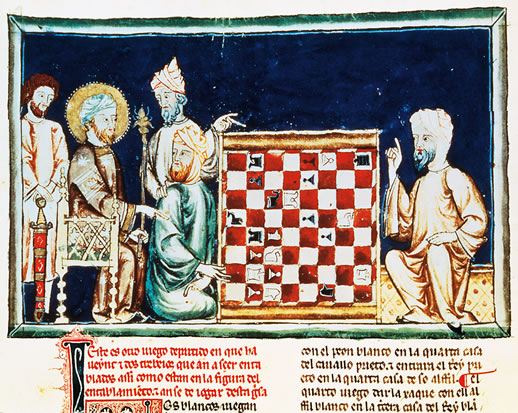One has to conclude that regarding Jefferson’s affinity to Islam and his possible inspiration from the Qur’an, there is no there there.
Paradise Lost?
In 711 A.D., a Muslim raiding party, made up mostly of recently conquered and converted Berbers, crossed to Spain from Africa and unexpectedly defeated Roderic, the king of the Visigoths. This represented the farthest western expansion of the Ummayad Empire, which had come to power in 656 in the first Islamic Civil War, and whose seat was in Greek-speaking Damascus. Taking advantage of the triumph, a greater force of Muslim soldiers came to Spain and in a few years pushed the Christians out, except for the northwest and along the Pyrenees. A Muslim thrust into France met defeat at the hands of Charles Martel in the Battle of Tours in 732.
In 750, the Abbasids deposed and slaughtered the Ummayads and would soon establish their capital in newly constructed Baghdad amidst the former holdings of the defeated Persian Empire. This new power, the Abbasid empire, in one form or another would survive until the Mongol invasion of 1258. But back in Spain, a surviving Ummayad prince, Abd al-Rahman I, declared his independence from the Abbasid rulers and established a separate Emirate of Córdoba in 756 that would rule most of Spain for almost 200 years. It is this emirate that has received praise from Western scholars as a place and time of flourishing culture, of tolerance and cooperation between Muslims, Christians, and Jews, in contrast to the persecutions being carried out in Christendom.
The political control of the Córdoba emirs, however, was unsteady until Abd al-Rahman III, who centralized power, declared himself a caliph in 929, extended his sway over North Africa and even looked to expand his power against the Fatimids in Egypt. By the end of that century, however, the Caliphate had broken into self-ruled administrative units, called Taifas, and the Caliphate formally ended in 1031. The first Taifa period is dated 1009 to 1110.
During this period, the Christians of the north slowly began returning southward. When they regained Toledo, the Taifa leaders asked for assistance, and the Almoravids came up from North Africa in 1085 and prevented the Christians from advancing further. The Almoravids were tyrannical and whatever cooperation there had been among the three great religions came to an end. But their rule too eventually disintegrated and a second Taifa period, 1140 to 1203, ensued. An even more militant group, the Almohads, then gained control of Muslim Spain. Its presence is dated from 1147 to 1248. Their defeat by the Christian armies in 1212 hastened the re-Christianization of the Iberian peninsula. During a third Taifa period, 1232-1287, much of the rest of Spain, except for the Emirate of Granada in the southern province of Andalusia, fell to the Christians. Granada itself finally succumbed in 1492.
In The Myth of the Andalusian Paradise: Muslims, Christians, and Jews under Islamic Rule in Medieval Spain, Darío Fernández-Morera seeks to explode the generally accepted characterization of Moorish Spain as a place of tolerance, culture, and learning. However, the historical outline that I have related above is missing from the book, so the reader begins the trek through it with no historical guideposts by which to understand or judge the author’s thesis.
Nor is this the only organizational fault in the volume. It reads like a Ph.D. thesis, with the author wanting to demonstrate the breadth of his historical research (it is, in fact prodigious), but at the expense of a well-constructed argument. The Myth of the Andalusian Paradise veers between genuine scholarship, pedantry, and advocacy. The very title clearly states what the author’s thesis is, but the coherence of his argument is lost in a pastiche of extended treatments of definitions of words, attacks on Muslim social practices, a digression on the intolerance of Maimonides, and his underlying implication that Islam is incapable of permitting any real tolerance or mutual respect among Muslims and non-Muslims.
Nonetheless, by the end of the work, much of the rosy spectacle of Moorish Spain that lives in the modern mind has been dismantled. The worst element of conventional opinion on this subject concerns Los Reyes Católicos, Ferdinand and Isabella of Spain. The general impression today is that after 1492, Ferdinand and Isabella, having conquered Granada, expelled Jews and Muslims and later even the converted Muslims, and then plunged Spain into a period of the Inquisition and dark intolerance. What Fernández-Morera demonstrates is that each of the major groups in Spain practiced the same kind of exclusivity, suppression of heretical sects, and expulsion of those who were of different faiths or who had nominally converted. And contrary to the idea of a golden age of Moorish Spain eclipsing what came after, the truth is the opposite: Spain’s literary, artistic, religious, and musical culture after the Reconquista was far superior to what Moorish Spain had enjoyed in its heyday.
Fernández-Morera begins each chapter with an excerpt from effusive descriptions of the glory and tolerance of Al-Ándalus, the Muslim name for Spain. He then seeks to contrast the “myth” with the facts on the ground. Unfortunately, due to the problems with the organization of his presentation, the reader must work at distilling the appropriate facts that are germane to the argument.
And sometimes he uses those facts inconsistently. For example, he bemoans how a group a Berbers destroyed what was beginning to be a burgeoning Visigothic-Roman civilization. Although little remains of that civilization because of the depredations of the Muslim armies, Fernández-Morera declares that the Visigoths had become quite Romanized, and were melding what they received from that culture with their own to create a vibrant and unique synthesis. Yet in speaking of the cultural successes of the Spanish Muslims, he deprecates their accomplishments as drawing on the native Christian culture and utilizing the Christian scholars and bureaucrats who served the emir or caliph. One culture (the Visigoth) is praised for borrowing from its (Roman) hosts, while the other (Islamic) is denigrated for borrowing from its (Christian) hosts.
He correctly delineates the insatiable appetite of the Muslim rulers for slaves, and how much the economy was dependent on slave labor, but he barely mentions the thousands of Muslims who were sold into slavery under Spanish conquests. Moreover, he correctly indicates the central role that Middle Eastern Islam played in the African slave trade but deflects how much Spain became involved in it after 1492.
The author is at pains to show that whatever successes in culture and learning Spanish Islam enjoyed came from the interactions of Jews, Christians, and Muslims only at the upper levels of society, even as everyday Christians were subject to a demeaning place in society. He is correct, but then again it is always the elites that drive the higher culture.
More convincing is Fernández-Morera’s showing that the suppressive, tributary status of dhimmi of the subjected ordinary Christians placed them in a socially and financially abject status. The most ignominious employment was reserved for Christians. Being near a Christian was polluting for a Muslim. The jizya or tributary tax was collected in a degrading manner and was set at a level far higher than what was expected (the zakat) from Muslims. It was these cumulative pressures that forced Christians either to convert or to flee. During the Almoravid and Almohad regimes, the Christians who refused to convert were expelled to Africa, or fled to the north, or were exterminated. The Jews met the same fate. Abu Yusuf, the Ahmohad emir, bragged, according to Fernández-Morera, that “he had left no church or synagogue standing in Al-Ándalus.” In fact, by the time Granada fell, there were no dhimmis left at all.
Moreover, the earlier Muslim tolerance for the religious practices of the Christians was limited. Christians could not build new churches. In some areas, they had to remove crosses from public view. They could not ring bells. Hundreds of churches were destroyed or turned into mosques. The architectural heritage of Christian Visigoth Spain is virtually gone forever.
The author is also correct that the Maliki school of the Shari’a, dominant in Spain, was stricter than the Hanafi or Shafi’I schools, which were dominant in the other parts of the Islamic empire. That meant that ordinary Muslims in Spain also had a hard time of it. As for followers of the other Shari’a schools in Spain, they were regarded as apostates and rigorously suppressed or killed.
He mentions, but does not emphasize, that just when Muslim Spain was amassing its highest level of cultural accomplishments, so was the Abbasid empire in Baghdad. But soon, both would be shattered by internal divisions. The high culture, admirable as it may have been, did not survive the warring of Muslims against other Muslims. It certainly was not there in 1492 when the last emirate fell.
The best written and most revealing part of the book is its analysis of the internal structures of the Christian, Muslim, and Jewish groups in Spain. Each were implacable against internal deviations. The Jews successfully extinguished the Kairaite sect, so that virtually nothing remains of their writings. Internally, the Jews imposed an orthodox rabbinical form of Judaism, enforcing it within their community with severe punishments. They too, steered clear of “defiling” relations with ordinary Christians. The Jews were best treated by the Muslims during the Taifa periods, when the various principalities needed Jewish expertise. That ended with the accession of the Ahmoravids and particularly the Almohads.
The Christians similarly had their exclusionary practices, with particular discriminations against Jews, an inheritance from Visigoth law. They also successfully suppressed heretical dissent, in particular, the Arians. Like converted Jews, Christians who accepted forced conversion to Islam became a separate class, the maludis, and held something like a lower caste status in Muslim Spain. Many, however, were crypto-Catholics, and staged resistance to the regime, or revolted, or gave assistance to the invading Christian armies from the north. Eventually, the maludis, whether crypto-Catholic or not, were expelled.
When Granada fell, Ferdinand and Isabella expelled the Jews who did not convert and gave the same ultimatum to the Muslims. Both Jews and Muslims had many “conversions” that were merely superficial. The converted Muslims, the moriscos, remained suspect. Some did work for a return of Islamic rule. Like the regimes before, Spain in the early 17th century sought to expel the moriscos. Those who were able to remain merged with the dominant Christian population.
In the end, Fernández-Morera does not give sufficient credit to the cultural achievements of Muslim Spain, in particular during the late 10th century. But he does show that the notion of a free and a broadly accepting tolerance by the Muslims for the Jews and the Catholics is a myth; that such tolerance as there was was limited to Jewish and Christian elites; and that it was in any case relatively short-lived. Most significantly, he shows that the intolerance practiced by Catholic Spain toward Muslims and Jews was but a replication of the way that Muslim, Jewish, and Visigoth predecessors ruled over their own communities in Medieval times.


